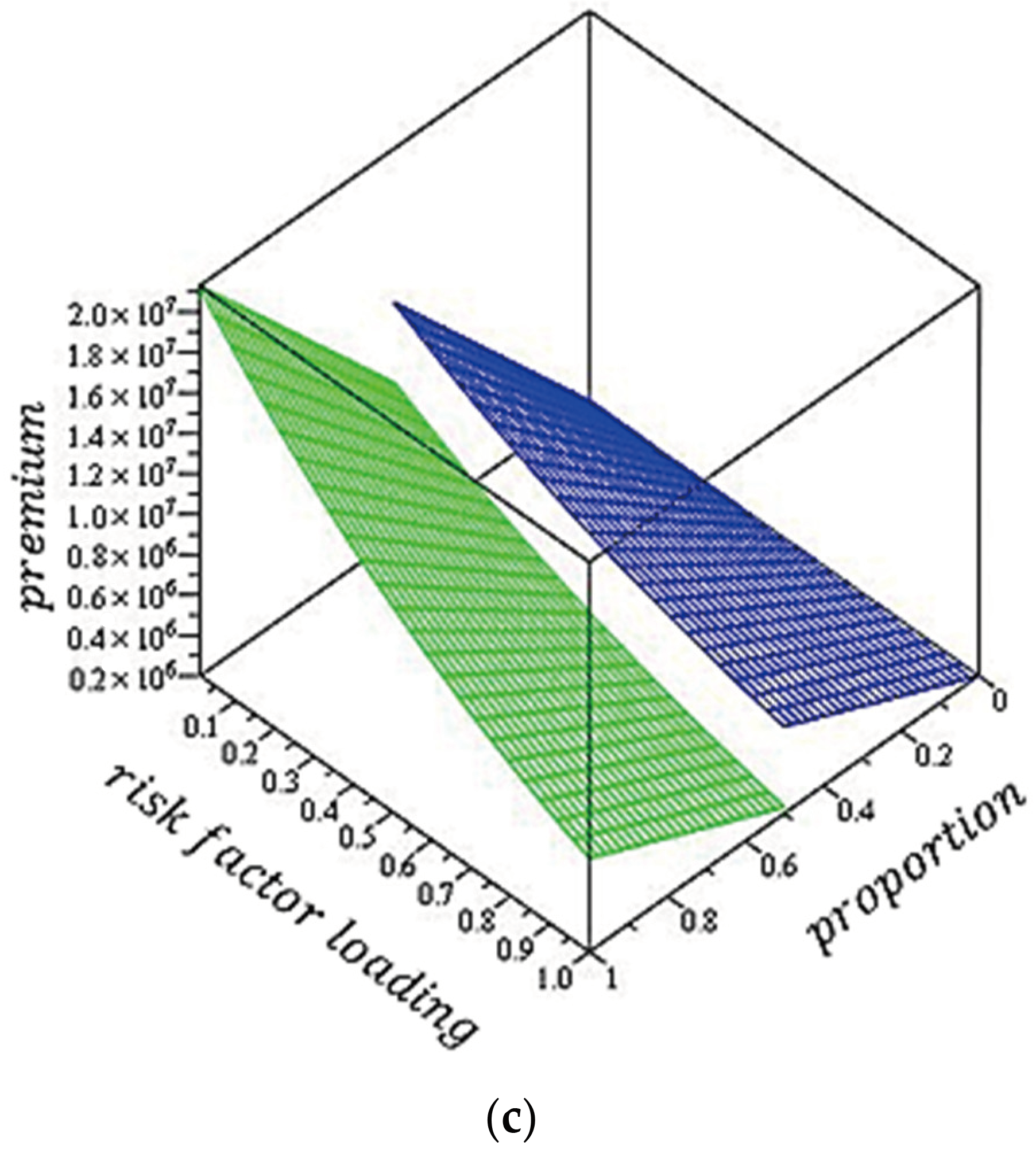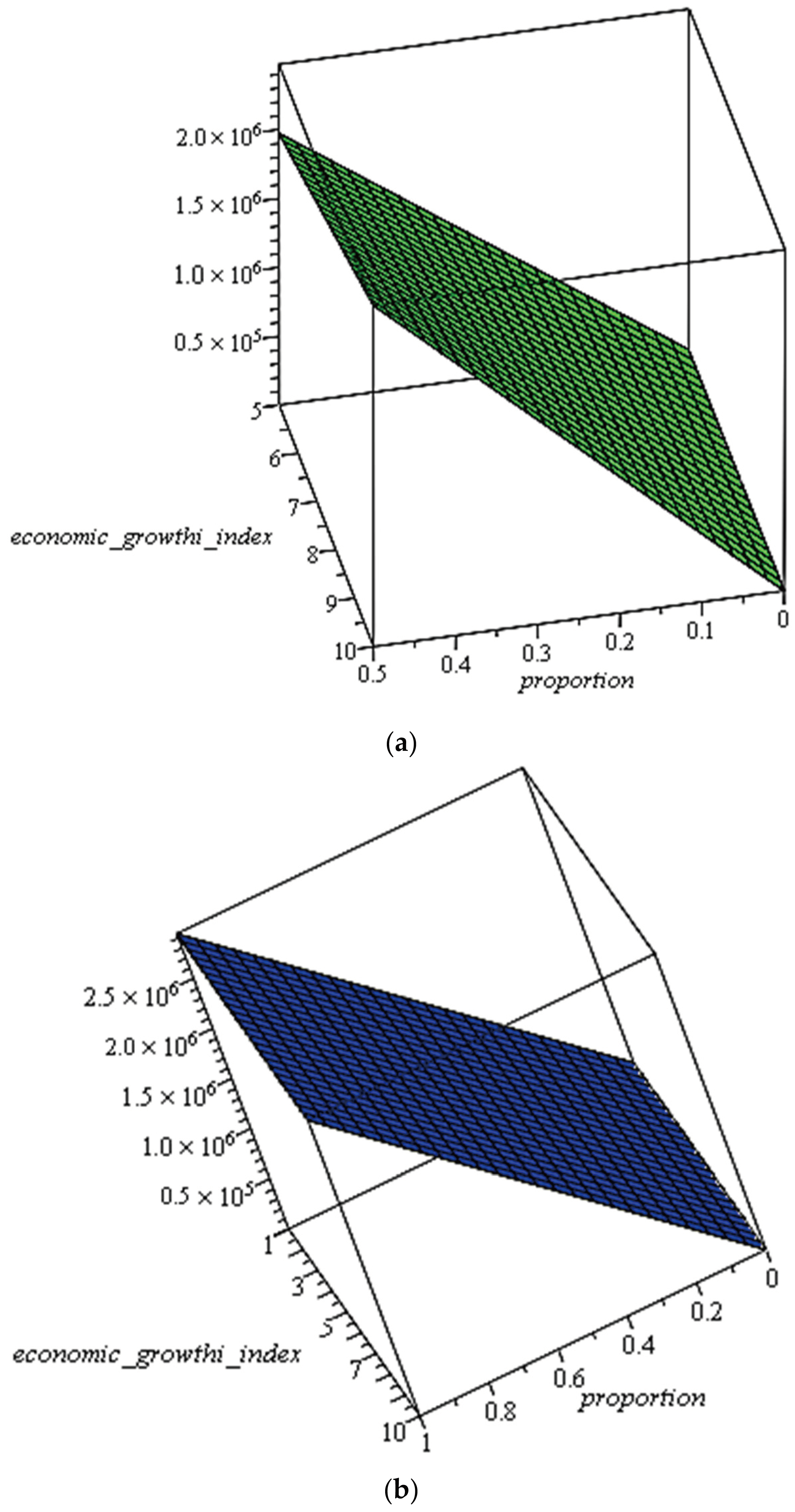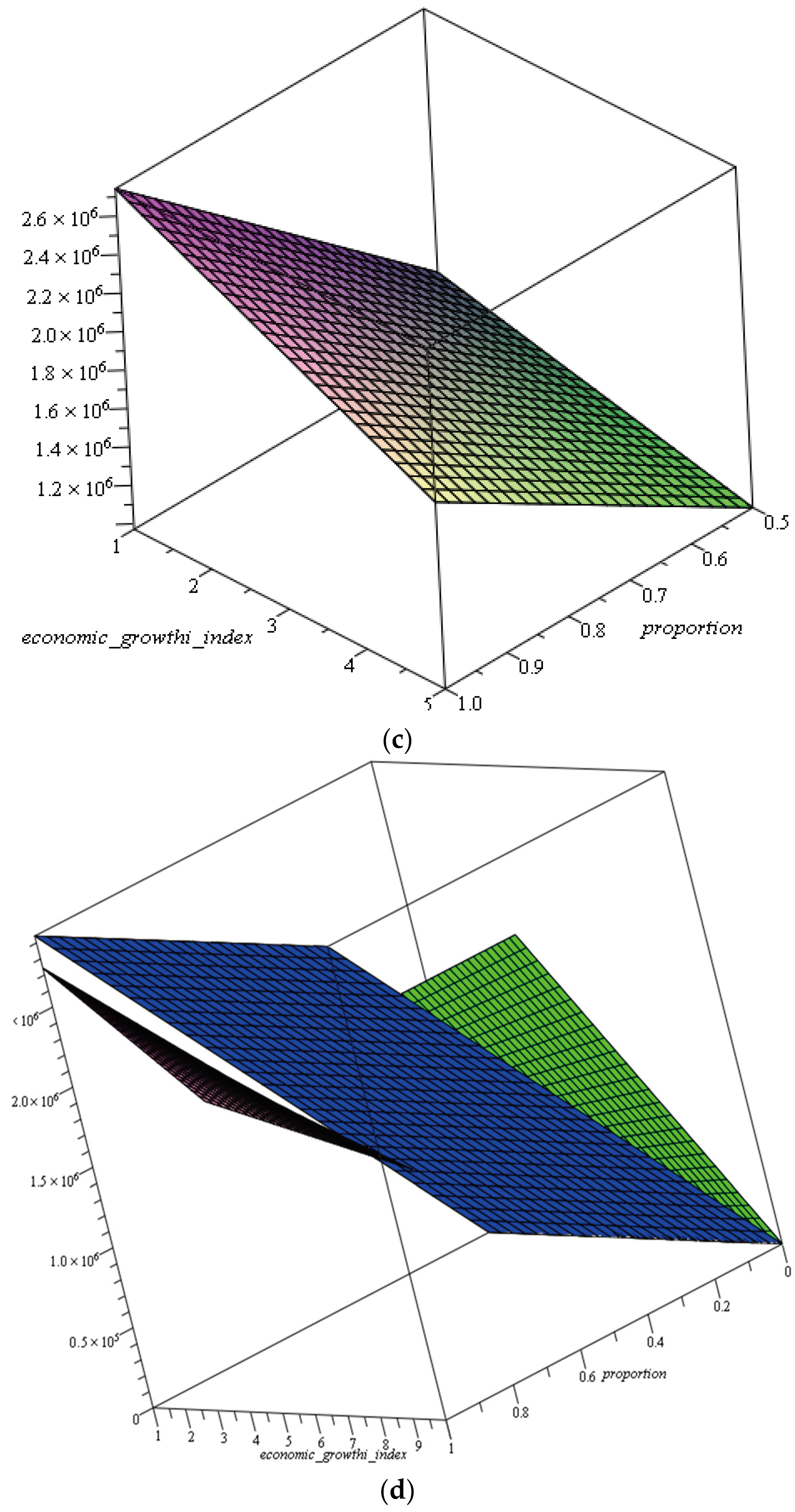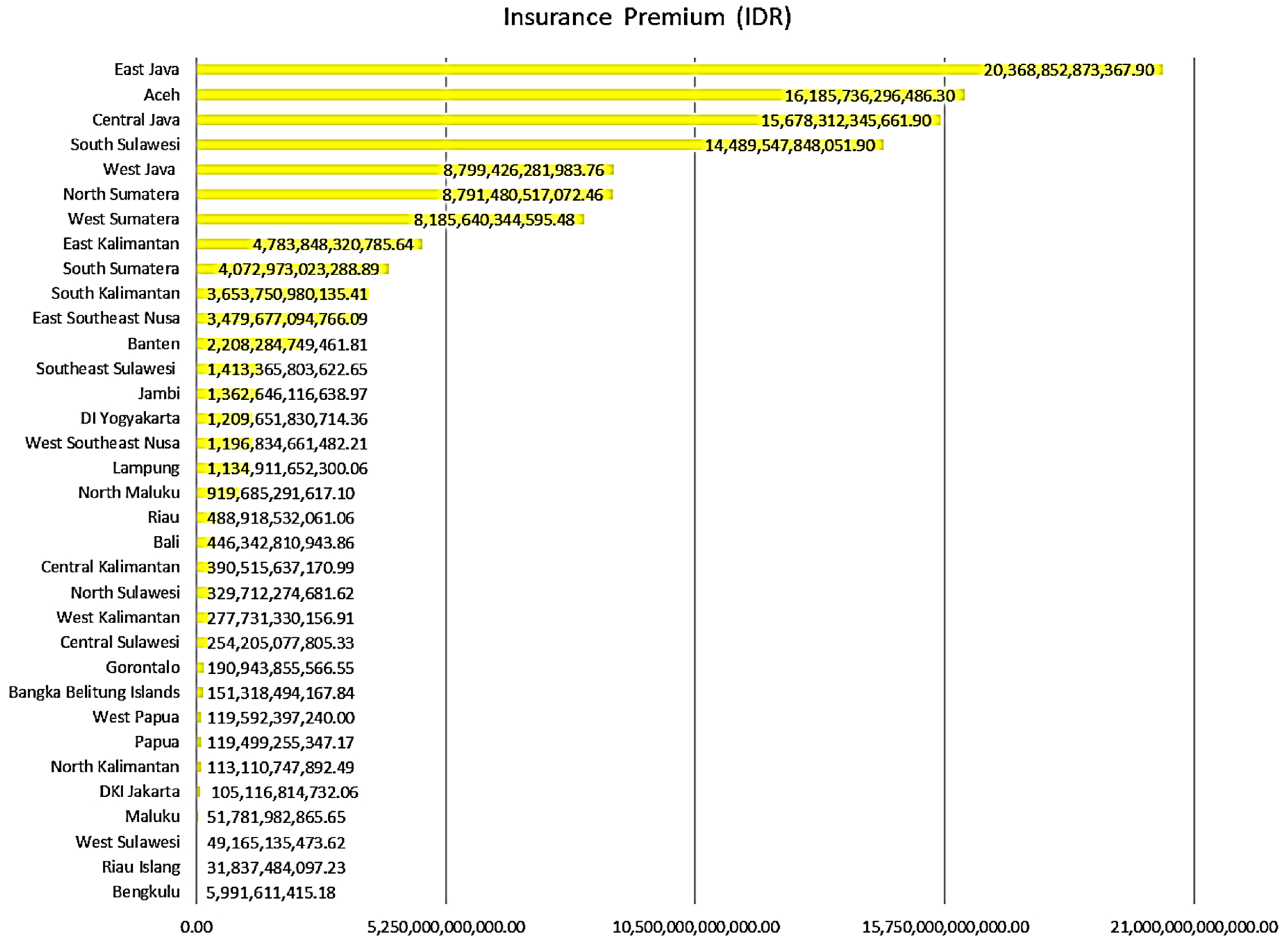Development of the Black–Scholes Model for Determining Insurance Premiums to Mitigate the Risk of Disaster Losses Using the Principles of Mutual Cooperation and Regional Economic Growth
Abstract
:1. Introduction
2. Materials and Methods
2.1. Materials
2.2. Method
2.2.1. Modelling Frequencies of Disaster Events
2.2.2. Modeling Disaster Loss
2.2.3. Collective Risk Model
2.2.4. Black–Scholes Model
3. Results
3.1. The Developed Black–Scholes Model
- 1.
- The conditions and .
- 2.
- The conditions and .
- 3.
- The conditions and or and .
3.2. Black–Scholes Model Simulation on the Natural Disaster and Economic Growth Rate Data
4. Discussion
5. Conclusions
Author Contributions
Funding
Data Availability Statement
Acknowledgments
Conflicts of Interest
References
- Acha, Ikechukwu, and Mfon Sampson Ukpong. 2012. Micro-Insurance: A Veritable Product Diversification Option for Micro-Finance Institutions in Nigeria. Research Journal of Finance and Accounting 3: 78–85. [Google Scholar]
- Aduloju, Sunday Adekunle, and Sunday Stephen Ajemunigbohun. 2017. Reinsurance and Performance of the Ceding Companies: The Nigerian Insurance Industry Experience. Economics and Business 31: 19–29. [Google Scholar] [CrossRef]
- Berger, Marc A. 1993. Markov Jump Processes. In An Introduction to Probability and Stochastic Processes. New York: Springer, pp. 121–38. [Google Scholar] [CrossRef]
- Bloch, Daniel Alexandre. 2023. A Review of ‘The Pricing of Options and Corporate Liabilities’. SSRN Electronic Journal. [Google Scholar] [CrossRef]
- Bressan, Silvia. 2018. The impact of reinsurance for insurance companies. Risk Governance and Control: Financial Markets & Institutions 8: 22–29. [Google Scholar]
- Bryc, Wlodzimierz. 1995. Normal Distributions. In The Normal Distribution, Characterizations with Application. 100 vols. New York: Springer, pp. 23–38. [Google Scholar] [CrossRef]
- Cahyandari, Rini, Kalfin, Sukono, Sri Purwani, Dewi Ratnasari, Titin Herawati, and Sutiono Mahdi. 2023. The Development of Sharia Insurance and Its Future Sustainability in Risk Management: A Systematic Literature Review. Sustainability 15: 8130. [Google Scholar] [CrossRef]
- Chen, Cheng-Wu, Chun-Pin Tseng, Wen-Ko Hsu, and Wei-Ling Chiang. 2012. A Novel Strategy to Determine the Insurance and Risk Control Plan for Natural Disaster Risk Management. Natural Hazards 64: 1391–403. [Google Scholar] [CrossRef]
- Chen, Shuai, and Jiameng Yang. 2023. Environmental Pollution Liability Insurance Pricing and the Solvency of Insurance Companies in China: Based on the Black–Scholes Model. International Journal of Environmental Research and Public Health 20: 1630. [Google Scholar] [CrossRef] [PubMed]
- Dickson, D. C. M. 2016. The Collective Risk Model. In Insurance Risk and Ruin. Cambridge: Cambridge University Press, pp. 53–94. [Google Scholar]
- Ermolieva, Tatiana, Tatiana Filatova, Yuri Ermoliev, Michael Obersteiner, Karin de Bruijn, and Adriaan Jeuken. 2017. Flood Catastrophe Model for Designing Optimal Flood Insurance Program: Estimating Location-Specific Premiums in the Netherlands. Risk Analysis 37: 82–98. [Google Scholar] [CrossRef] [PubMed]
- Fang, Kuangnan, Yefei Jiang, and Malin Song. 2016. Customer Profitability Forecasting Using Big Data Analytics: A Case Study of the Insurance Industry. Computers & Industrial Engineering 101: 554–64. [Google Scholar] [CrossRef]
- Gikhman, Iosif Ilyich, and Anatoli Vladimirovich Skorokhod. 2004. Jump Processes. In The Theory of Stochastic Processes II. Berlin: Springer, pp. 187–257. [Google Scholar] [CrossRef]
- Giudice, Manlio Del, Federica Evangelista, and Matteo Palmaccio. 2015. Defining the Black and Scholes Approach: A First Systematic Literature Review. Journal of Innovation and Entrepreneurship 5: 5. [Google Scholar] [CrossRef]
- Ismail, Emad. 2016. The Complementary Compound Truncated Poisson-Weibull Distribution for Pricing Catastrophic Bonds for Extreme Earthquakes. British Journal of Economics, Management & Trade 14: 1–9. [Google Scholar] [CrossRef]
- Jametti, Mario, and Thomas von Ungern-Sternberg. 2004. Disaster Insurance or a Disastrous Insurance-Natural Disaster Insurance in France. SSRN Electronic Journal. [Google Scholar] [CrossRef]
- Johny, Mohammad, Bambang Purwoko, and Endang Etty Merawaty. 2021. Effect of Gross Premiums, Claims Reserves, Premium Reserves, and Payment 418 of Claims to ROA: A Survey of General Insurance Companies Is Recorded in IDX. International Journal of Economics, Management, Business and Social Science 1: 31–43. [Google Scholar]
- Joyette, Antonio R. T., Leonard A. Nurse, and Roger S. Pulwarty. 2015. Disaster Risk Insurance and Catastrophe Models in Risk-prone Small Caribbean Islands. Disasters 39: 467–92. [Google Scholar] [CrossRef] [PubMed]
- Kalfin, Sukono, Sudradjat Supian, and Mustafa Mamat. 2021. Mitigation and Models for Determining Premiums for Natural Disaster Insurance Due to Excessive Rainfall. Journal of Physics: Conference Series 1722: 012058. [Google Scholar] [CrossRef]
- Kalfin, Sukono, Sudradjat Supian, and Mustafa Mamat. 2022a. Insurance Premium Determination Model as Natural Disaster Mitigation Effort in Indonesia with A Cross Subsidy System. International Journal of Agricultural and Statistical Sciences 18: 539–46. [Google Scholar]
- Kalfin, Sukono, Sudradjat Supian, and Mustafa Mamat. 2022b. Insurance as an Alternative for Sustainable Economic Recovery after Natural Disasters: A Systematic Literature Review. Sustainability 14: 4349. [Google Scholar] [CrossRef]
- Kousky, Carolyn, and Erwann Michel-Kerjan. 2017. Examining Flood Insurance Claims in the United States: Six Key Findings. Journal of Risk and Insurance 84: 819–50. [Google Scholar] [CrossRef]
- Kunreuther, Howard. 1996. Mitigating Disaster Losses through Insurance. Journal of Risk and Uncertainty 12: 171–87. [Google Scholar] [CrossRef]
- Kunreuther, Howard. 2015. The Role of Insurance in Reducing Losses from Extreme Events: The Need for Public–Private Partnerships. The Geneva Papers on Risk and Insurance-Issues and Practice 40: 741–62. [Google Scholar] [CrossRef]
- Kunreuther, Howard, and Rosemary Lyster. 2016. The Role of Public and Private Insurance in Reducing Losses from Extreme Weather Events and Disasters. Asia Pacific Journal of Environmental Law 19: 29–54. [Google Scholar] [CrossRef]
- Lee, Chen-Ying. 2017. Product Diversification, Business Structure, and Firm Performance in Taiwanese Property and Liability Insurance Sector. The Journal of Risk Finance 18: 486–99. [Google Scholar] [CrossRef]
- Lee, Chen-Ying. 2020. The Impact of Product Diversification on Risk-Taking Behavior in Property and Liability Insurance Firms. Journal of Applied Finance and Banking 10: 177–97. [Google Scholar]
- Li, Jiayi, Zhiyan Cai, Yixuan Liu, and Chengxiu Ling. 2022a. Extremal Analysis of Flooding Risk and Its Catastrophe Bond Pricing. Mathematics 11: 114. [Google Scholar] [CrossRef]
- Li, Wenping, Yuming Wu, Xing Gao, and Wei Wang. 2022b. Characteristics of Disaster Losses Distribution and Disaster Reduction Risk Investment in China from 2010 to 2020. Land 11: 1840. [Google Scholar] [CrossRef]
- Lima, Ricardo Carvalho de Andrade, and Antonio Vinícius Barros Barbosa. 2019. Natural Disasters, Economic Growth and Spatial Spillovers: Evidence from a Flash Flood in Brazil. Papers in Regional Science 98: 905–25. [Google Scholar] [CrossRef]
- Linnerooth-Bayer, Joanne, and Aniello Amendola. 2000. Global Change, Natural Disasters and Loss-Sharing: Issues of Efficiency and Equity. The Geneva Papers on Risk and Insurance-Issues and Practice 25: 203–19. [Google Scholar] [CrossRef]
- Luis, Alamilla-López Jorge. 2015. An Approximation to the Probability Normal Distribution and Its Inverse. Ingeniería, Investigación y Tecnología 16: 605–11. [Google Scholar] [CrossRef]
- Ma, Zong-Gang, and Chao-Qun Ma. 2013. Pricing Catastrophe Risk Bonds: A Mixed Approximation Method. Insurance: Mathematics and Economics 52: 243–54. [Google Scholar] [CrossRef]
- Ma, Zonggang, Chaoqun Ma, and Shisong Xiao. 2017. Pricing Zero-Coupon Catastrophe Bonds Using EVT with Doubly Stochastic Poisson Arrivals. Discrete Dynamics in Nature and Society 2017: 1–14. [Google Scholar] [CrossRef]
- McAneney, John, Delphine McAneney, Rade Musulin, George Walker, and Ryan Crompton. 2016. Government-Sponsored Natural Disaster Insurance Pools: A View from down-Under. International Journal of Disaster Risk Reduction 15: 1–9. [Google Scholar] [CrossRef]
- Morales-Bañuelos, Paula, Nelson Muriel, and Guillermo Fernández-Anaya. 2022. A Modified Black-Scholes-Merton Model for Option Pricing. Mathematics 10: 1492. [Google Scholar] [CrossRef]
- Osaki, Shunji. 1992. Poisson Processes. In Applied Stochastic System Modeling. Berlin and Heidelberg: Springer, pp. 63–82. [Google Scholar] [CrossRef]
- Pascucci, Andrea. 2011. Black-Scholes Model. In PDE and Martingale Methods in Option Pricing. Milano: Springer, pp. 219–56. [Google Scholar] [CrossRef]
- Paudel, Youbaraj, Wouter Botzen, Jeroen Aerts, and Theo Dijkstra. 2015. Risk Allocation in a Public–Private Catastrophe Insurance System: An Actuarial Analysis of Deductibles, Stop-loss, and Premiums. Journal of Flood Risk Management 8: 116–34. [Google Scholar] [CrossRef]
- Peng, Jiazhen, Xiaojun Gene Shan, and Yang Gao. 2014. Modeling the Integrated Roles of Insurance and Retrofit in Managing Natural Disaster Risk: A Multi-Stakeholder Perspective. Natural Hazards 74: 1043–68. [Google Scholar] [CrossRef]
- Philippi, Tim, and Jörg Schiller. 2024. Abandoning disaster relief and stimulating insurance demand through premium subsidies. Journal of Risk and Insurance 91: 339–82. [Google Scholar] [CrossRef]
- Picard, Pierre. 2008. Natural Disaster Insurance and the Equity-Efficiency Trade-Off. Journal of Risk and Insurance 75: 17–38. [Google Scholar] [CrossRef]
- Powell, Lawrence S., and David W. Sommer. 2005. Internal versus External Capital Markets in the Insurance Industry: The Role of Reinsurance. SSRN Electronic Journal. [Google Scholar] [CrossRef]
- Quan, Zhiyu, and Emiliano A. Valdez. 2018. Predictive Analytics of Insurance Claims Using Multivariate Decision Trees. Dependence Modeling 6: 377–407. [Google Scholar] [CrossRef]
- Reijnen, Rajko, Willem Albers, and Wilbert C. M. Kallenberg. 2005. Approximations for Stop-Loss Reinsurance Premiums. Insurance: Mathematics and Economics 36: 237–50. [Google Scholar] [CrossRef]
- Sewu, Pan Lindawaty Suherman, Rahel Octora, and Floria Lusiana. 2022. Analysis of the Existence of Insurance Fraud in the Case of Insurance Claim Payment Failure and the Legal Protection for Insurance Clients in the Insurance Company’s Failure to Pay Claims. European Journal of Law and Political Science 1: 79–86. [Google Scholar] [CrossRef]
- Shi, Peijun, Tao Ye, Ying Wang, Tao Zhou, Wei Xu, Juan Du, Jing’ai Wang, Ning Li, Chongfu Huang, Lianyou Liu, and et al. 2020. Disaster Risk Science: A Geographical Perspective and a Research Framework. International Journal of Disaster Risk Science 11: 426–40. [Google Scholar] [CrossRef]
- Shinde, Akank Sha, and Kalyanrao Chimaji Takale. 2012. Study of Black-Scholes Model and Its Applications. Procedia Engineering 38: 270–79. [Google Scholar] [CrossRef]
- Skees, Jerry R., Barry J. Barnett, and Anne G. Murphy. 2008. Creating Insurance Markets for Natural Disaster Risk in Lower Income Countries: The Potential Role for Securitization. Agricultural Finance Review 68: 151–67. [Google Scholar] [CrossRef]
- Subartini, Betty, Puri Puspa Damayanti, Sudradjat Supian, Ruly Budiono, Mohd Khairul Amri Kamarudin, Adiana Ghazali, and Muhammad Barzani Gasim. 2018. Fuzzy Inference System of Tsukamoto Method in Decision Making on Determination of Insurance Premium Amount for Due Damages of Flood Natural Disaster. Journal of Fundamental and Applied Sciences 10: 79–94. [Google Scholar]
- Sukono, Sukono, Kalfin Kalfin, Riaman Riaman, Sudradjat Supian, Yuyun Hidayat, Jumadil Saputra, and Mustafa Mamat. 2022. Determination of the Natural Disaster Insurance Premiums by Considering the Mitigation Fund Reserve Decisions: An Application of Collective Risk Model. Decision Science Letters 11: 211–22. [Google Scholar] [CrossRef]
- Supian, Sudradjat, and Mustafa Mamat. 2022. Insurance Premium Determination Model and Innovation for Economic Recovery Due to Natural Disasters in Indonesia. Computation 10: 174. [Google Scholar] [CrossRef]
- Suwandani, Ria Novita, and Yogo Purwono. 2021. Implementation of Gaussian Process Regression in Estimating Motor Vehicle Insurance Claims Reserves. Journal of Asian Multicultural Research for Economy and Management Study 2: 38–48. [Google Scholar] [CrossRef]
- Syuhada, Khreshna, Venansius Tjahjono, and Arief Hakim. 2024. Compound Poisson–Lindley process with Sarmanov dependence structure and its application for premium-based spectral risk forecasting. Applied Mathematics and Computation 467: 128492. [Google Scholar] [CrossRef]
- Tao, Zhengru, Xiaxin Tao, and Ping Li. 2009. Pricing Model for Earthquake CAT Bonds. Paper presented at the 2009 International Conference on Business Intelligence and Financial Engineering, Beijing, China, July 24–26; Piscataway: IEEE, pp. 740–44. [Google Scholar] [CrossRef]







| Region | (IDR) | ||||
|---|---|---|---|---|---|
| Provinces with a high economic growth rate and low potential disaster index | |||||
| DKI Jakarta | 5.46 | 0.2256048 | 21.7 | 0.6 | 30,106,909,810.95 |
| Central Java | 5.17 | 0.4686533 | 598.2 | 16.0 | 4,530,651,960.62 |
| Central Kalimantan | 6.53 | 0.4676314 | 27.9 | 0.7 | 38,729,763,312.62 |
| North Sulawesi | 5.24 | 0.4914887 | 25.4 | 0.7 | 35,368,311,283.38 |
| Gorontalo | 7.23 | 0.4462761 | 20.4 | 0.5 | 28,353,108,132.67 |
| Provinces with a low economic growth rate and low potential disaster index or provinces with a high economic growth rate and high potential disaster index | |||||
| Jambi | 4.46 | 0.4885638 | 46.6 | 1.2 | 64,744,471,582.52 |
| South Sumatera | 4.11 | 0.4906782 | 65.6 | 1.8 | 91,197,630,272.00 |
| Riau Island | −0.08 | 0.4101906 | 13.5 | 0.4 | 18,707,206,026.95 |
| DI Yogyakarta | 4.78 | 0.4965984 | 43.5 | 1.2 | 60,506,118,714.15 |
| East Java | 4.88 | 0.4735869 | 358.2 | 9.6 | 16,222,654,836.86 |
| Banten | 5.06 | 0.5457579 | 51.9 | 1.4 | 72,198,125,152.80 |
| Bali | 3.90 | 0.456108 | 31.8 | 0.9 | 44,283,463,877.29 |
| West Southeast Nusa | 1.10 | 0.4512449 | 45.4 | 1.2 | 63,136,821,231.57 |
| East Southeast Nusa | 3.98 | 0.4964927 | 62.0 | 1.7 | 86,228,527,891.81 |
| West Kalimantan | 5.54 | 0.5427625 | 67.6 | 1.8 | 93,974,480,554.34 |
| East Kalimantan | 10.09 | 0.5413529 | 3.3 | 0.1 | 831,739,925,812.43 |
| North Kalimantan | 4.17 | 0.4880352 | 27.5 | 0.7 | 38,291,312,893.05 |
| Central Sulawesi | 7.70 | 0.5108353 | 25.8 | 0.7 | 35,806,761,702.95 |
| South Sulawesi | 6.33 | 0.5620386 | 96.2 | 2.6 | 133,727,296,033.42 |
| Southeast Sulawesi | 6.10 | 0.5558012 | 44.5 | 1.2 | 61,821,469,972.86 |
| West Sulawesi | 5.27 | 0.5867065 | 14.0 | 0.4 | 19,437,955,538.77 |
| Maluku | 5.72 | 0.5657388 | 14.6 | 0.4 | 20,314,856,377.91 |
| North Maluku | 5.99 | 0.5131964 | 11.7 | 0.4 | 498,079,366,701.85 |
| Papua | −16.36 | 0.4330964 | 13.6 | 1.4 | 18,853,357,354.28 |
| Provinces with a low economic growth rate and high potential disaster index | |||||
| Aceh | 3.45 | 0.5412119 | 2.3 | 2.7 | 142,496,297,300.00 |
| North Sumatera | 3.61 | 0.5116106 | 84.5 | 2.3 | 117,504,637,634.15 |
| West Sumatera | 3.14 | 0.5269398 | 82.1 | 2.2 | 114,143,189,167.33 |
| Riau | 2.51 | 0.5189757 | 33.1 | 0.9 | 46,037,265,555.57 |
| Bengkulu | 4.49 | 0.5708838 | 16.1 | 0.4 | 22,360,957,148.43 |
| Lampung | 4.18 | 0.5172489 | 43.6 | 1.2 | 60,652,270,041.48 |
| Bangka Belitung Islands | 3.95 | 0.5692628 | 10.0 | 3.0 | 13,884,254,974.09 |
| West Java | 4.30 | 0.5138307 | 391.7 | 10.5 | 5,407,552,799.76 |
| South Kalimantan | 3.26 | 0.5108 | 63.9 | 1.7 | 88,859,230,409.23 |
| West Papua | −0.13 | 0.5107965 | 3.9 | 0.1 | 544,701,230,441.91 |
| Province | Insurance Premium (IDR) | |
|---|---|---|
| Insurance premiums for provinces that provide subsidies | ||
| DKI Jakarta | 105,116,814,732.06 | 0.7787 |
| Central Java | 15,678,312,345,661.90 | 0.7787 |
| Central Kalimantan | 390,515,637,170.99 | 0.7787 |
| North Sulawesi | 329,712,274,681.62 | 0.7787 |
| Gorontalo | 190,943,855,566.55 | 0.7787 |
| Insurance premiums for provinces that do not provide or receive subsidies | ||
| Jambi | 1,362,646,116,638.97 | 0.7787 |
| South Sumatera | 4,072,973,023,288.89 | 0.7787 |
| Riau Islang | 31,837,484,097.23 | 0.7787 |
| DI Yogyakarta | 1,209,651,830,714.36 | 0.7787 |
| East Java | 20,368,852,873,367.90 | 0.7787 |
| Banten | 2,208,284,749,461.81 | 0.7787 |
| Bali | 446,342,810,943.86 | 0.7787 |
| West Southeast Nusa | 1,196,834,661,482.21 | 0.7787 |
| East Southeast Nusa | 3,479,677,094,766.09 | 0.7787 |
| West Kalimantan | 277,731,330,156.91 | 0.7787 |
| East Kalimantan | 4,783,848,320,785.64 | 0.7787 |
| North Kalimantan | 113,110,747,892.49 | 0.7787 |
| Central Sulawesi | 254,205,077,805.33 | 0.7787 |
| South Sulawesi | 14,489,547,848,051.90 | 0.7787 |
| Southeast Sulawesi | 1,413,365,803,622.65 | 0.7787 |
| West Sulawesi | 49,165,135,473.62 | 0.7787 |
| Maluku | 51,781,982,865.65 | 0.7787 |
| North Maluku | 919,685,291,617.10 | 0.7787 |
| Papua | 119,499,255,347.17 | 0.7787 |
| Insurance premiums for provinces that receive subsidies | ||
| Aceh | 16,185,736,296,486.30 | 0.7787 |
| North Sumatera | 8,791,480,517,072.46 | 0.7787 |
| West Sumatera | 8,185,640,344,595.48 | 0.7787 |
| Riau | 488,918,532,061.06 | 0.7787 |
| Bengkulu | 5,991,611,415.18 | 0.7787 |
| Lampung | 1,134,911,652,300.06 | 0.7787 |
| Bangka Belitung Islands | 151,318,494,167.84 | 0.7787 |
| West Java | 8,799,426,281,983.76 | 0.7787 |
| South Kalimantan | 3,653,750,980,135.41 | 0.7787 |
| West Papua | 119,592,397,240.00 | 0.7787 |
Disclaimer/Publisher’s Note: The statements, opinions and data contained in all publications are solely those of the individual author(s) and contributor(s) and not of MDPI and/or the editor(s). MDPI and/or the editor(s) disclaim responsibility for any injury to people or property resulting from any ideas, methods, instructions or products referred to in the content. |
© 2024 by the authors. Licensee MDPI, Basel, Switzerland. This article is an open access article distributed under the terms and conditions of the Creative Commons Attribution (CC BY) license (https://creativecommons.org/licenses/by/4.0/).
Share and Cite
Purwandari, T.; Hidayat, Y.; Sukono; Kalfin; Ibrahim, R.A.; Subiyanto. Development of the Black–Scholes Model for Determining Insurance Premiums to Mitigate the Risk of Disaster Losses Using the Principles of Mutual Cooperation and Regional Economic Growth. Risks 2024, 12, 110. https://doi.org/10.3390/risks12070110
Purwandari T, Hidayat Y, Sukono, Kalfin, Ibrahim RA, Subiyanto. Development of the Black–Scholes Model for Determining Insurance Premiums to Mitigate the Risk of Disaster Losses Using the Principles of Mutual Cooperation and Regional Economic Growth. Risks. 2024; 12(7):110. https://doi.org/10.3390/risks12070110
Chicago/Turabian StylePurwandari, Titi, Yuyun Hidayat, Sukono, Kalfin, Riza Andrian Ibrahim, and Subiyanto. 2024. "Development of the Black–Scholes Model for Determining Insurance Premiums to Mitigate the Risk of Disaster Losses Using the Principles of Mutual Cooperation and Regional Economic Growth" Risks 12, no. 7: 110. https://doi.org/10.3390/risks12070110








